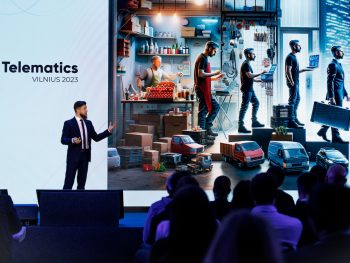Three things that global fleets must get right
Aliaksandr Kuushynau, head of Wialon, on why telematics integration, driver empowerment and sustainable electrification are fundamental basics for global fleets.
Fleet owners and operators worldwide may be facing challenges and pressures of varying natures and different degrees of urgency, depending on the regions, sectors or industries they serve, but through our work with over 2,600 fleet and telematics service providers, in 150 countries, I see several key ways in which fleet management is evolving.
Unstoppable merge: OEM and aftermarket telematics integration
The fleet management industry is witnessing an emerging trend towards the integration of OEM (Original Equipment Manufacturer) telematics and aftermarket telematics systems. Currently, there are approximately 100 million vehicles worldwide equipped with aftermarket telematics, showcasing a significant market presence. However, there is also a vast number of vehicles equipped with OEM telematics, which, until now, have largely operated independently of aftermarket systems.
This situation presents a landscape where two substantial but distinct markets exist: one for OEM telematics and another for aftermarket solutions. Historically, these systems have functioned on separate platforms, leading to a fragmentation in the way fleet owners and managers collect, analyse and utilise vehicle data. This separation has often resulted in inefficiencies and missed opportunities in data analysis and utilisation.
However, we are now increasingly seeing a gradual merging of these two markets. The integration of OEM and aftermarket telematics represents a significant stride towards a more unified, efficient approach to fleet management. By bringing all data together onto unified platforms, like Wialon, the industry can leverage a more holistic view of vehicle performance, driver behaviour and operational efficiency.
As this trend gains momentum, it is poised to reshape the landscape of fleet management, offering a more cohesive, efficient and data-driven approach. This shift is not just a technological evolution but also a strategic one, as it aligns with the broader trends of digital transformation and data integration in the industry.
Not only control but also driver-friendly technologies
The integration of driver-friendly AI and Advanced Driver Assistance Systems (ADAS) in vehicles is particularly pertinent in addressing the global driver shortage, which is a significant challenge in the trucking and logistics industries. Video telematics is an important aspect of this technological integration, offering critical benefits that extend beyond traditional telematics systems.

Driver-centric technologies are crucial in preparing for the future evolution of the transportation and logistics industry
Incorporating AI and ADAS, along with video telematics, into vehicles reduces the cognitive load on drivers. Features such as traffic updates, route optimisation and voice-activated controls are essential for long-haul journeys, where driver fatigue is a major concern. By improving the overall job satisfaction and reducing the stress associated with driving, these technologies make driving professions more appealing, and help address the issue of driver shortages.
The widespread adoption of these technologies in fleets worldwide marks a pivotal step for the future of transportation. They are the stepping stones towards the adoption of semi-autonomous and autonomous vehicles, potentially providing a long-term solution to driver shortages. Familiarising drivers with these advanced technologies, including video telematics, will likely lead to a smoother transition to more automated systems in the future.
In summary, the emphasis on driver-centric technologies such as AI, ADAS and video telematics is crucial in tackling the current driver shortage and preparing for the future evolution of the transportation and logistics industry. This approach aligns technological advancement with workforce development, ensuring the industry’s resilience and adaptability in a rapidly changing global landscape.
Electrification of fleets needs reliable integration of electric vehicle data into fleet management platforms
The electrification of fleets and the integration of electric vehicle data into fleet management platforms represent a significant step towards achieving decarbonisation and net zero goals. This trend aligns with the global push towards sustainability and the reduction of carbon emissions. Fleet management platforms are increasingly being designed to assist fleet managers in this transition by incorporating features that specifically cater to the unique needs of electric vehicles.
One key functionality of modern fleet management platforms is the ability to analyse the specific routes and mileage of a fleet, to determine which parts are most suitable for electrification. By considering factors such as distance, charging infrastructure availability, and the type of operations (such as urban deliveries or long-haul trips), these platforms can provide fleet managers with data-driven insights. This enables them to make informed decisions about which vehicles to transition to electric models, ensuring an efficient and cost-effective shift towards a greener fleet.
Moreover, these platforms offer support in managing the unique aspects of EV operations. This includes monitoring battery health and charge levels, optimising charging schedules to reduce energy costs, and ensuring compliance with local environmental regulations. By providing a comprehensive view of the fleet’s performance and environmental impact, these platforms play a crucial role in helping fleet managers meet their sustainability objectives.
The evolution of fleet management platforms to support the electrification of fleets is a critical development in the transportation industry. It not only aids in reducing carbon emissions but also supports organisations in achieving their environmental goals in a practical and effective manner. As the adoption of electric vehicles continues to grow, these platforms will become increasingly vital in managing the complexities and maximizing the benefits of a sustainable, electrified fleet.
____________________________
About Wialon
Wialon is a leading global platform for telematics and IoT, with 3.8 million connected vehicles in more than 150 countries.
With more than 20 years of experience, Wialon has helped thousands of companies optimise their operations by effectively processing and analysing telematics data.
Being a flexible and multifunctional system, Wialon helps deliver any telematics project of any scale and for any industry.
Wialon is developed by Gurtam, a European GPS tracking and IoT solutions developer with headquarters in Vilnius and offices in Boston, Dubai, and Tbilisi.










